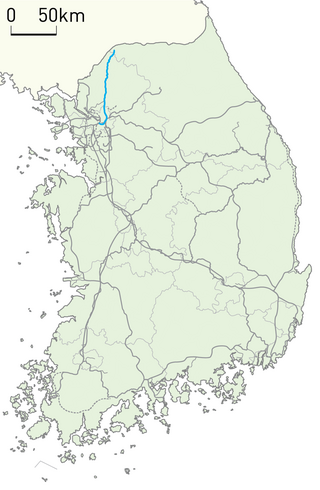Top Qs
Timeline
Chat
Perspective
Gyeongwon Line
Railway line in South Korea From Wikipedia, the free encyclopedia
Remove ads
The Gyeongwon Line is a railway line serving northeastern Gyeonggi Province in South Korea. The line is operated by Korail. The name of the line came from Gyeongseong (Seoul) and Wonsan, the original terminus of the line, in what is now North Korea.
Remove ads
Remove ads
History
Summarize
Perspective
One of the first construction projects undertaken by the Railway Bureau of the Government General of Korea was for an east−west trunk line to connect Keijō to the important port of Wonsan. The Chosen Government Railway (Sentetsu) opened the line in several stages between 1911 and 1914.[1] The first section of mainline to be electrified by Sentetsu was also along the Gyeongwon Line, with the Pokkye−Gosan section being energised on 27 March 1944,[2] as part of a plan made jointly with the South Manchuria Railway for an electrified railway all the way from Busan to Xinjing, capital of Manchukuo.[3]
After the partition of Korea following the end of the Pacific War in 1945, the Gyeongwon Line was split along the 38th parallel between the stations of Hantangang and Choseongni.[4] The railways in both South and North were nationalised, and the newly-established Korean National Railroad took over operation of the truncated Gyeongwon Line, from Seoul to Choseongni; in the North, the Korean State Railway merged its section of the Gyeongwon Line, Choseong-ri−Wonsan, with the Wonsan−Gowon section of the former Hamgyeong Line to create the Gangwon Line.[4]
The line was severely damaged during the Korean War. After the ceasefire and the subsequent establishment of the Military Demarcation Line, the division of the line changed, with the South gaining control of the line further northwards as far as Woljeongni. However, the line was rebuilt only as far as Sintalli, resulting in an operation line from Yongsan and Sintalli with a length of 88.8 km (55.2 mi).[1]
Following the 1961 coup, the Supreme Council for National Reconstruction started South Korea's first five-year plan, which included a construction program to complete the railway network, to foster economic growth.[5] As part of the program, in the outskirts of Seoul, a 4.9 km (3.0 mi) long avoiding line was built from Kwangwoon University to Mangu on the Jungang Line, called the Mangu Line, which opened on December 30, 1963.[5]
Upgrade
The section of the Gyeongwon Line in the Seoul metropolitan area was among the first to be electrified with the 25 kV/60 Hz AC catenary system in South Korea when to allow for through train services with Seoul Subway Line 1. Further sections were electrified and urban services to Line 1 was extended in the 1980s and then in the 2000s:[6]
Altogether 55.6 km (34.5 mi) of the line was electrified, and 53.1 km (33.0 mi) was double-tracked.[1]
On September 1, 2010, the South Korean government announced a strategic plan to reduce travel times from Seoul to 95% of the country to under 2 hours by 2020. As part of the plan, the Gyeongwon Line is to be further upgraded until Uijeongbu for 230 km/h and may see KTX service.[7]
In 2012 restoration of the line was completed between Sintan-ri and Baengmagoji.[8]
On December 16, 2023, a single-line railway between Soyosan and Yeoncheon opened on the Seoul Metropolitan Subway Line 1.
Remove ads
Route
Summarize
Perspective
A yellow background in the "Distance" box indicates that section of the line is not electrified.
Remove ads
See also
References
Bibliography
External links
Wikiwand - on
Seamless Wikipedia browsing. On steroids.
Remove ads

